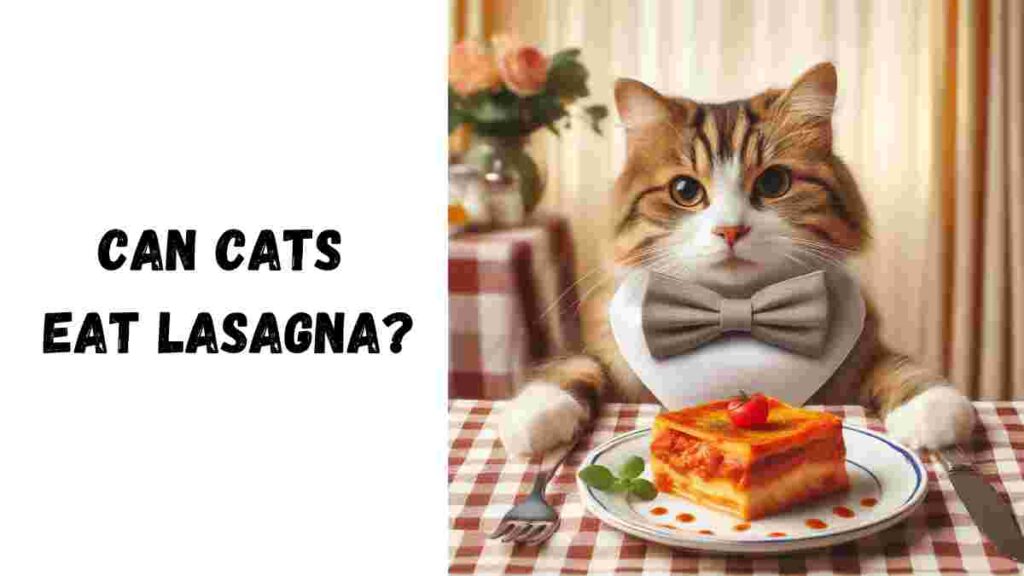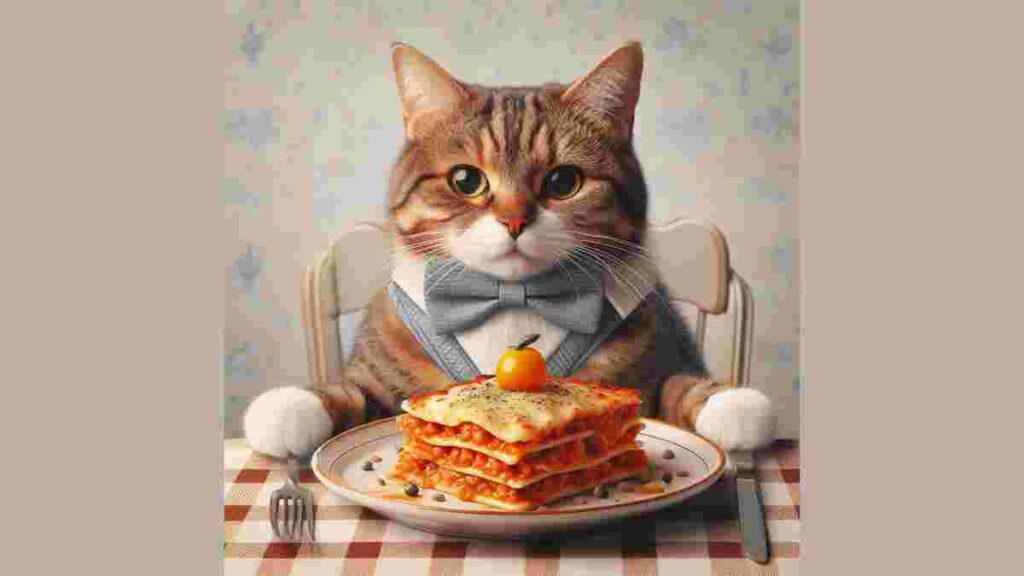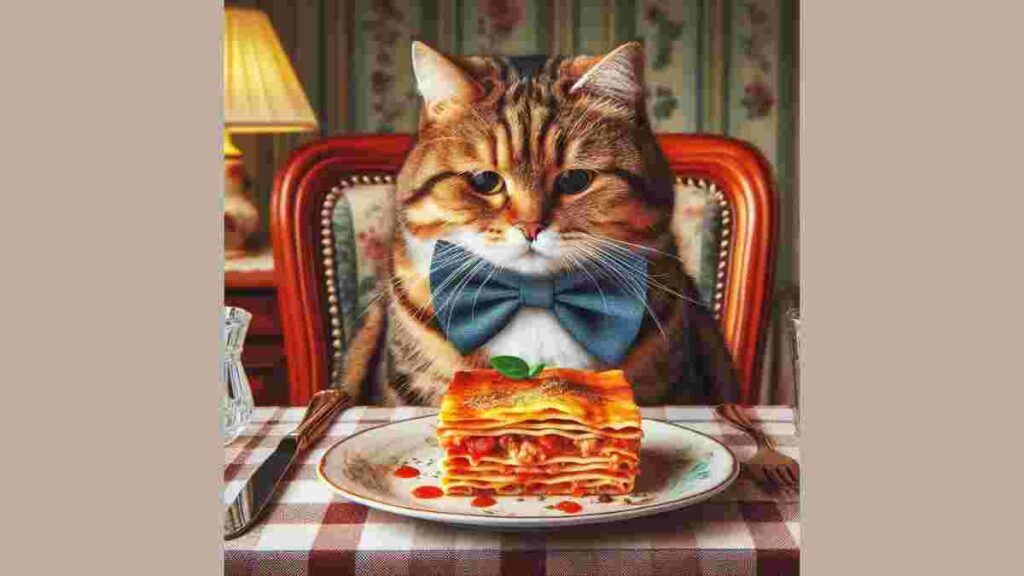Can Cats Eat Lasagna: Cats are enigmatic creatures, beloved by many and known for their particular tastes and independent nature. One hallmark of feline behavior is their curious attraction toward human food. This has sparked a plethora of questions among cat lovers, and at the top of the list is whether cats can partake in the iconic Italian dish – lasagna.
Feeding our feline friends is not as straightforward as it might seem, especially when it comes to our table scraps. But to truly understand if cats can eat lasagna, we must first explore the intricate world of feline digestion and nutrition.
Click here to get the best food for your feline friend

Table of Contents
Understanding Feline Digestive System – Can Cats Eat Lasagna?
Before we can answer the question of lasagna and cats, it’s important to grasp the unique digestive system of felines. Cats are obligate carnivores, meaning their natural diet consists primarily of animal tissues. Their digestive tract is specialized to process raw meat efficiently and relies on a high-protein, moderate-fat diet for optimal health.
The Anatomy of a Cat’s Digestive Tract
The feline digestive system is relatively short compared to omnivorous animals, implying a diet that is efficiently broken down and absorbed. Here’s a quick look at the key components:
- The Mouth and Teeth: Designed for shearing meat, not grinding grains or tubers.
- The Salivary Glands: Produce saliva with a lower pH than other mammals, important for the digestion of animal proteins.
- The Esophagus: A muscular tube that quickly ushers food to the stomach.
- The Stomach: Highly acidic to handle raw meats and kill bacteria efficiently.
- The Small Intestine: Where the majority of digestion and nutrient absorption occurs.
- The Large Intestine and Colon: Deal mainly with water absorption and fermentation of leftover nutrients.
Can Cats Eat Lasagna?
Lasagna, a rich, multi-layered pasta dish typically containing cheese, meat, and tomato sauce, is a classic comfort food for humans. But how does it fare for our feline companions?
Ingredient Analysis
In any given lasagna recipe, several components stand out as potential issues for cats:
- Pasta: Grains like wheat, the primary ingredient in pasta, are not a natural part of a cat’s diet and provide little nutritional value.
- Cheese: Dairy products, though high in protein and calcium, can lead to digestive upset due to lactose intolerance in many adult cats.
- Tomato Sauce: Tomatoes are part of the nightshade family and can be toxic to cats, particularly if unripe or in large amounts.
- Spices and Herbs: Cats have a much more acute sense of taste and smell, which means strong spices can be overwhelming or unappetizing.
Expert Insights and Risks
Veterinary professionals are generally unanimous in their stance on feeding cats lasagna. While a small nibble might not cause catastrophic harm, repeated or larger portions could lead to various health issues, including:
- Digestive Upset: Cats eating foods high in fat, especially if it’s not part of their regular diet, may experience vomiting, diarrhea, or pancreatitis.
- Obesity: The rich and calorie-dense nature of lasagna can contribute to weight gain, which in turn can lead to a host of other health concerns like diabetes and joint problems.
- Nutritional Imbalance: A diet high in one particular food may lead to a cat missing out on essential nutrients that are well-balanced in their proper cat food.

Safe Human Foods for Cats
Pet owners may find it tempting to share a meal with their cat, but it’s crucial to understand what foods are safe for occasional snacks and which ones to avoid completely.
Occasionally Safe Treats
- Cooked or Grilled Meats: Small amounts of plain cooked chicken or turkey can sometimes be offered as a treat.
- Rice: Plain, cooked rice can help settle a cat’s stomach if they are experiencing digestive upset.
Never Feed These Foods to Cats
- Chocolate: Contains theobromine, which is toxic to cats (and dogs!).
- Alcohol and Caffeine: Highly toxic to cats, as their bodies metabolize these substances much more slowly than humans.
- Xylitol: An artificial sweetener that you might find in sugar-free gum or candy – extremely toxic to cats and dogs.
Balancing Treats with a Cat’s Diet
Treats should not comprise more than 10% of a cat’s daily calorie intake and should ideally complement their regular diet, not replace it. Always opt for high-quality, cat-specific treats.
Understanding Cat Nutrition
Cats require specific nutrients to thrive, and it’s the responsibility of the pet owner to ensure they are provided in the proper balance.
Essential Nutrients
Vitamins, minerals, fatty acids, and taurine are just some of the crucial nutrients in a cat’s diet. Here’s a brief overview:
- Protein: Essential for growth, maintenance, and various bodily functions.
- Taurine: An amino acid critical for heart health and vision.
- Fatty Acids: Omegas support skin and coat health, among other benefits.
Choosing the Right Cat Food
Selecting a high-quality commercial cat food designed to meet the nutritional needs of cats is the safest route for most pet owners. Look for foods labeled as “complete and balanced” and verified by the Association of American Feed Control Officials (AAFCO).
Commercial vs. Homemade
While some pet owners opt for homemade cat food, it requires rigorous planning and often the supplementation of additional nutrients. It’s essential to consult a veterinary nutritionist before starting your cat on a homemade diet.

The Dangers of Feeding Human Food to Cats
The appeal of sharing our favorite human foods with our pets comes with several risks that can’t be overlooked.
Common Toxic Human Foods for Cats
- Grapes and Raisins: Can cause kidney failure.
- Onions and Garlic: In all forms—fresh, cooked, or powdered—can destroy a cat’s red blood cells, leading to anemia.
- Avocado: Contains persin, which can cause vomiting and diarrhea in cats.
Potential Health Risks
Feeding human food to cats can lead to a myriad of health problems, such as obesity, malnutrition, gastrointestinal upset, and even more severe conditions in some instances.
Signs of Food-Related Illnesses
If your cat displays any of the following symptoms after consuming human food, it’s best to contact your veterinarian:
- Vomiting or diarrhea
- Lethargy
- Excessive thirst or urination
- Change in stool consistency or color
Alternatives to Lasagna for Cats
If you’re looking for ways to treat your cat without compromising their health, consider more cat-friendly recipes and treats.
Homemade Cat Treats
Simple treats like plain, cooked meats or freeze-dried fish can be a source of joy for your cat without the risks associated with full-blown human dishes.
Specialty Cat Foods
There are also specialized cat foods designed to mimic the flavors of many human favorites, from salmon to chicken and more, in forms that cater to feline dietary needs.
Crafting a Balanced Diet
Discussing dietary adjustments with a veterinarian can help ensure your cat’s diet is balanced and specific to their needs, which can change over their lifetime.
Tips for Introducing New Foods to Cats
When introducing any new food to your pet, it’s important to do so gradually and with awareness for potential allergies or intolerances.
Gradual Introductions
Whether it’s a new type of cat food, a homemade treat, or even a reassessment of portion sizes, slow introductions can help prevent stomach upsets.
Allergy Monitoring
Watch for symptoms such as itchy skin, vomiting, diarrhea, or excessive gas, which could indicate your cat has an allergy or intolerance to a particular food.
Getting Veterinary Guidance
Your veterinarian is an invaluable resource for any questions related to your cat’s diet and can provide personalized advice based on your cat’s history and current health status.
Frequently Asked Questions (FAQs) – Can Cats Eat Lasagna?
Can Cats Eat Cheese?
Most cats are lactose intolerant, meaning that consuming dairy products like cheese can lead to digestive upset. While a small amount on rare occasions might be fine for some cats, consider cheese an occasional special treat at best.
Is it Safe for Cats to Eat Pasta?
Plain, cooked pasta offers no nutritional value to cats and can be difficult for them to digest. It’s generally not recommended for regular consumption.
What Should I Do if My Cat Accidentally Eats Human Food?
If your cat ingests something they shouldn’t have, monitor their behavior and look for any unusual symptoms. If in doubt, err on the side of caution and contact your vet.
How Can I Tell if My Cat is Allergic to a Certain Food?
Keep an eye out for skin issues or gastrointestinal problems after introducing a new food. Your vet can confirm allergies through testing if needed.
Can Cats Eat Cooked Meat from Lasagna?
Small amounts of plain, cooked meat from lasagna might be safe for some cats as an occasional treat, but it’s not a recommended part of their regular diet.
Wrapping Up – Can Cats Eat Lasagna?
Our love for cats often translates into wanting to share every aspect of our lives with them, including our meals. While a small taste of lasagna here and there might seem innocent, the potential risks associated with feeding human food to cats highlight the importance of a species-appropriate, balanced diet.
The intricacies of feline nutrition should guide our choices to ensure the long and healthy lives of our beloved pets.
Finally, reaching out to pet nutritionists or contacting your veterinarian can provide personalized guidance for your specific feline friend. Delve into the world of cat nutrition and foster a diet that celebrates the unique needs and flavors that cats truly enjoy.

Pingback: Can Cats Eat Vienna Sausages? The Truth Behind This Feline Food Feud [3 Powerful Findings] - Pawfect Pet Tips
Pingback: Rat Making Grunting Noises: Decoding Uncommon Rat Sounds [In 3 Powerful Steps] - Pawfect Pet Tips
Pingback: Rat Sneezing: Everything You Need To Know [3 Powerful Findings] - Pawfect Pet Tips
Pingback: Is Aspen Bedding Safe for Rats? [3 Powerful Methods] - Pawfect Pet Tips